
| What is Flavor and Fortune? |
| How do I subscribe? |
| How do I get past issues? |
| How do I advertise? |
| How do I contact the editor? |
Read 13031721 times
Connect me to:
| Home |
| Articles |
| Book reviews |
| Letters to the Editor |
| Newmans News and Notes |
| Recipes |
| Restaurant reviews |
| Article Index (all years, slow) |
| List of Article Years |
| Article Index (2025) |
| Article Index (last 2 years) |
| Things others say |
| Related Links |
| Log In... |
| Authors |
| Categories & Topics |
Mushrooms: Familiar and Less So--Part II
| by Jacqueline M. Newman |
Vegetables and Vegetarian Foods
Spring Volume: 2011 Issue: 18(1) page(s): 8, 9, 10, 11, and 12
Eight different mushrooms were discussed in Part I of this pair of articles; it was in Volume 17(4). They were black mushrooms, also known as black forest mushrooms and by their Japanese name of shiitake, also the bamboo pith, button, chicken of the woods, cloud ear, cordyceps, golden winter, and lion's mane mushrooms.
This second part looks at a handful of others. They are king oyster, oyster, pine, reishi, monkey head, and silver ear mushrooms. As did the previous article, one recipe for each mushrooms appears at the end of this article. Each gives its name in Chinese, most have a picture, as well. Mushrooms have changed their common names, some even their botanical name, so not every one has every one of these; only those with no confusion do.
Upcoming will be another article looking at still other mushrooms. It, too, will have one recipe for each of them. Following those recipes, there will be a few Chinese recipes using more than one kind of mushroom in a single dish. At the next article's end, as some have requested, there will be a reading list of items offering more detail than this magazine provides.
KING OYSTER MUSHROOMS are botanically known as Pleurotus cryngi.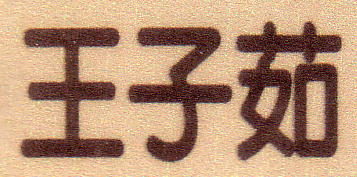 >
>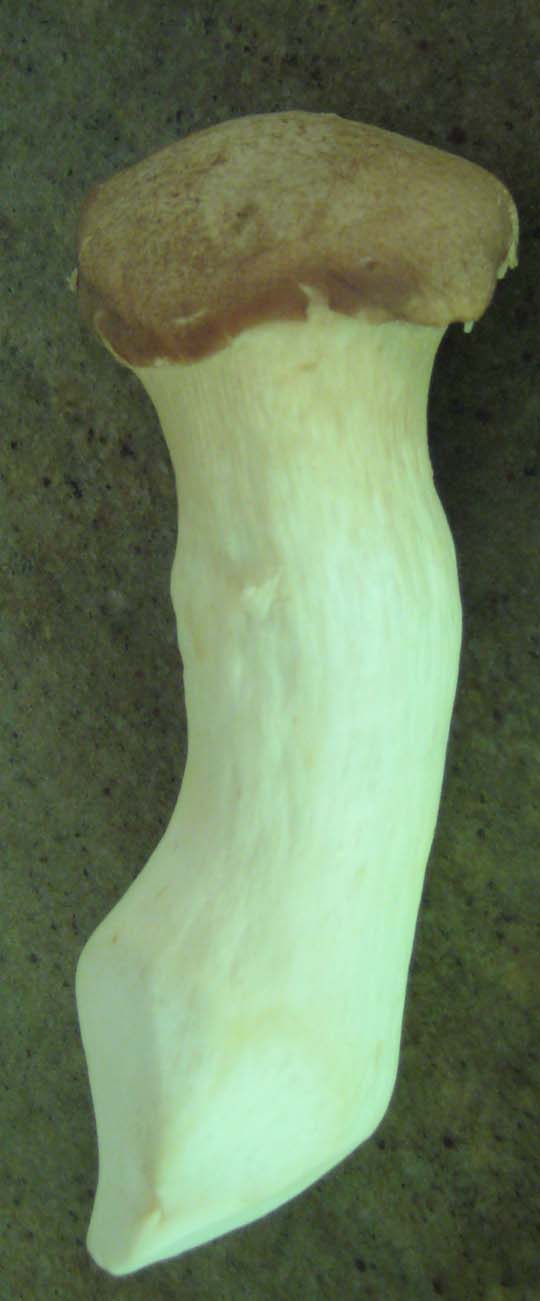 They are called ping gu by most Chinese. It should not they be confused with the common oyster mushroom, a relative, whose botanical name is Pleurotus ostreatus. As the name of this mushroom indicates, it is huge compared to most other mushrooms. And as do many other mushrooms, the king oyster mushroom has many other names including maple oyster and Miller's oyster, abalone oyster, and almond oyster mushroom. That last name is because at room temperature, some people perceive an almond-like aroma.
They are called ping gu by most Chinese. It should not they be confused with the common oyster mushroom, a relative, whose botanical name is Pleurotus ostreatus. As the name of this mushroom indicates, it is huge compared to most other mushrooms. And as do many other mushrooms, the king oyster mushroom has many other names including maple oyster and Miller's oyster, abalone oyster, and almond oyster mushroom. That last name is because at room temperature, some people perceive an almond-like aroma.
Little is written about this particular mushroom, probably because it is reasonably new in the marketplace. Some say it looks like an overfed Pleurotus cornucopiae with its large central one-inch thick stem. This mushroom can be somewhat flat on top and while the top of that Pleurotus which might look similar, has a cap that is more funnel-shaped.
Why this name? One source says because they smell like almonds and are as delicious as oysters. Another source refers to them as drummer sticks, a name only encountered once. Still another, incorrectly calls them 'shaggy mane' or 'shaggy ink cap mushroom' but these names definitely belongs to yet another mushroom. Like other errors in mushroom literature, the wrong names are repeated all too often, and can make it difficult when asking for or learning about a particular mushroom. However, in this case and others, a picture is worth a thousand words.
What is interesting is that this mushroom is reported to be about one-quarter protein. Medicinally, it is a food that Chinese say helps retain vigor and is useful for reducing weight. As to that mistakenly related drumstick report, that same source mistakenly named it botanically, and advises not to consume this mushroom with wine as it can easily produce a toxin. A mycologist thinks that is more mushroom mix-up. One author did call this fungus a chicken leg mushroom and says to use it in soup. While good in soups, there are many better ways to enjoy the king oyster mushroom, particularly when eating large pieces of it.
The king oyster mushroom retains its texture and is one of the few, perhaps the only mushroom that can stay firm during long cooking, though less so when deep fried and delicious. Chefs rarely use the king oyster mushroom whole as a single person would be hard-pressed to finish a whole one. Rather, they often slice or dice and put one mushroom in one dish to feed more than one person. When sliced, battered, and deep fried, this mushroom is similar in texture to eating a firm squash-like vegetable tasting like a yummy savory mushroom.
OYSTER MUSHROOMS or the Pleurotus ostreatus mushrooms; they are thin and usually white to grey. 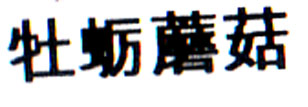
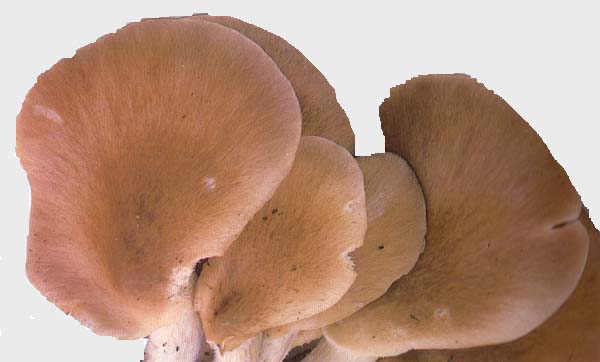 But, as indicated in Part I of this series of articles, oyster mushrooms can be found pink, blue, purple, and in other colors; and we did see all of these colors at a mushroom farm in Singapore.
But, as indicated in Part I of this series of articles, oyster mushrooms can be found pink, blue, purple, and in other colors; and we did see all of these colors at a mushroom farm in Singapore.
Sort of side-ways-growing, these mushrooms were once called Pleurotus cystidiosus but now are more commonly known as tree oyster mushrooms, oyster shelf mushrooms, or simply oyster mushrooms and Pleurotus ostreatus. The Chinese call them ping gu, not mispronounced ping gou as these latter two syllables mean apple.
In Japan, then and now, many advise they are relatives of the king oyster mushroom, but not everyone agrees. In any case the Japanese know these oyster mushrooms as hiratake and know that they can have semi-circular caps. In China, they were praised as far back as the Song Dynasty (960 - 1279 CE)and in a poem were called 'the mushroom of flower heaven.'
All oyster mushrooms are thin, and fan- or shell-shaped. Many say they taste of the sea and that is why they are so named. Others disagree and say their name comes from the fact that they look like the shell of an oyster. We do understand the relationship in looks, but never perceived an oyster taste when eating them raw or cooked.
Cultivated in north China and found in the wild, they usually grow on both live and dead hardwood trees and stumps. Some report they are most common on beech trees, and that they come back in the very same location year after year. Should you find some, do look again in that same spot next year.
Often infested with small beetles, they can grow in tiers, do have a pleasant aroma, and do have white gills that run down their short stems. More correctly, their stems are called stalks.
The oyster mushroom can be dried successfully, and do keep for some few days when fresh. We recommend using paper towels between layers of them when storing them in the refrigerator or they get soggy easily. If drying them, keep the oven or vegetable dryer at a very low temperature because they easily burn. The hot sun does a good drying job for those that live in very warm climate zones. Because we live in the temperate zone, we purchase ours commercially dried, or canned, or fresh. Dried ones have a more intense flavor, and they do re-hydrate in minutes.
For those that forage for their mushrooms, be aware that the pork belly mushroom or Pseudoclitocybe cyathiformus, looks like the oyster mushroom to the untrained eye. Often mistaken for them, caps of these look-a-likes are shaped more like a cup, are often brown-gray, and do grow on individual stems in both field or forest. Knowing this may not be enough to distinguish these two items that can be mistaken one for the other. One needs to know them apart because the Pseudoditocybe should never be eaten. Our recommendation, ONLY collect mushrooms when accompanied by a trained mycologist.
Oyster mushrooms, cultivated since the early 1970's also grow on all kinds of dried cereal crops, have many relatives with varying common and botanical names, and they can be found in various sizes and places. Smaller ones are more tender and more tasty. When shopping, do look for them. Their taste is excellent, sometimes fleeting, and these mushrooms can be cooked with all manner of foods, and in many different ways.
PINE MUSHROOMS are botanically known as Tricholoma matsutake. They can be found in markets labeled with their Japanese/botanical name of matsutake. This mushroom lives in a symbiotic relationship with pine trees, hence its name, and most often is collected and available fresh in the fall. When full-grown, these mushrooms can have long thick stems.
In China, they are mostly grown in Kunnming, a city in the south of the Yunnan Province. Some do come from locations in northern parts of China, but most of these are grown indoors, then dried and available year-round. These mushrooms are often in short supply, and not too many dried ones are exported.
Pine mushrooms are adored for their texture and for their taste, and they are best when small. They are highly prized by the Chinese whose traditional medicinal practitioners recommend them as a remedy for difficult labor, for acute gastritis, convulsions, worms, tonsilitis, and to lower a fever.
Not often found in cookbooks, these mushrooms and many other mushrooms can be grilled, baked, even baked in foil, sauteed briefly, and stir-fried briefly, too. Best when close to raw, and good in every size, do enjoy them and all mushrooms fresh, dried, canned, frozen, and certainly cooked. Keep in mind that young ones taste best, and that dried ones have more intense taste.
REISHI MUSHROOMS are almost always known by this, their Japanese name.
>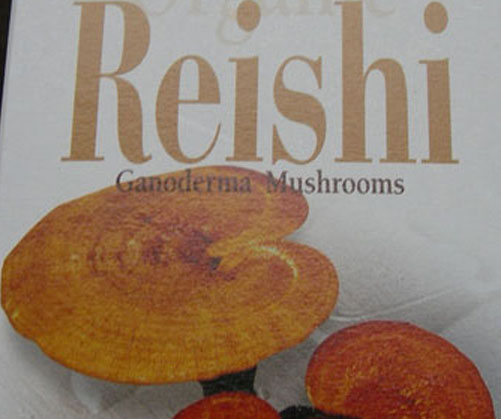 To the Chinese, these mushrooms are ling zhi, and botanically, they were known as Pancea polypore. They, like all mushrooms, have other names including the ten thousand year mushroom, the divine mushroom, and the mushroom of immortality. The Japanese call them mannentake, some northern Chinese use this name, as well. This lacquered-looking bracket fungus can look phony because they are covered in a shiny brightly colored coating and they sit on a reddish column or stem.
To the Chinese, these mushrooms are ling zhi, and botanically, they were known as Pancea polypore. They, like all mushrooms, have other names including the ten thousand year mushroom, the divine mushroom, and the mushroom of immortality. The Japanese call them mannentake, some northern Chinese use this name, as well. This lacquered-looking bracket fungus can look phony because they are covered in a shiny brightly colored coating and they sit on a reddish column or stem.
Most ling zhi are kidney or fan-shaped, pale-edged, with a tough mahogany colored crust on top, and when young they are white on the bottom. Now botanically known as Ganoderma lucidum, these fungi have little culinary interest among the general population, though quite a few recipes are beginning to appear in Chinese cookbooks. More often folks see them in pictures of potted plants, paintings, and other art works and wonder what they are; they do not think of them as food.
In China and several Asian countries, they are prized for their medicinal value. Said to enhance sleep, relieve high blood pressure, and heal all sorts of bodily damage, mostly they say they prolong life and that is why they are popular. Traditional Chinese medicinal (TCM) practitioners say this mushroom nourishes the lungs, protects the liver, helps the heart and kidneys, improves brain function, and improves qi. Not new to the Chinese, these heavy and hard fungi are written about in the Chinese Herbal Materia Medica. In that volume, they are called 'superior' and 'best among all Chinese herbals.' The first emperor of the Qin Dynasty (221 - 206 BCE) is said to have used them and deemed them desirable. Found in China, most of Asia, Europe, and North, South, and Central America, and in the United States, current research touts their many polysaccharides, alcohols, and their more than one hundred different tri-terpines, all having one or another affect on the body. They grow on tree trunks at or near ground level, almost always start out light and darken as they grow and age, taste bitter, and to the Chinese all medicine should taste that way; and they believe they have no toxicity.
In cooking, TCM doctors say to prepare them in soups and teas. Dried ones do need to be soaked for a day or more, and used in longer cooked dishes including those that are stewed. When very long-cooked, some TCM practitioners say they act as a hair tonic and a skin lightener. One can purchase powdered ones to use in any of these and other ways.
Flavor and Fortune did write about them and three other mushrooms in Volume 8(2) on page 21, and wrote about just the reishi in Volume 13(1) on pages 9, 10, and 16. Known as an Asian panacea, these mushrooms have spiritual potency, are said to increase qi, have anti-inflammatory impact, and decoctions of them positively impact the nervous system. The Japanese government approves their use as a cancer-fighting drug, says they inhibit some bacteria, may induce interferon production, increase DNA and RNA in bone marrow, and more.
What is interesting about their Chinese name and its symbolism is its spirituality to Asians. They believe this fungus impacts their lives for no other reason than its words. Ling is made of ideographs for rain, shaman, and praying, and zi speaks to its spiritual potency and that it makes elixirs. These and other reasons are why this mushroom is called the ten-thousand year mushroom. In general, many Asians purchase them, price is no object; and they are pricy. They hope using them will extend their life for many years.
MONKEY HEAD MUSHROOMS are now available whole, dried and sliced, and dried and powdered.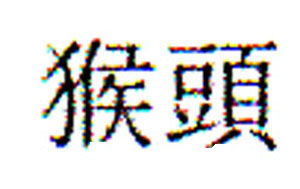
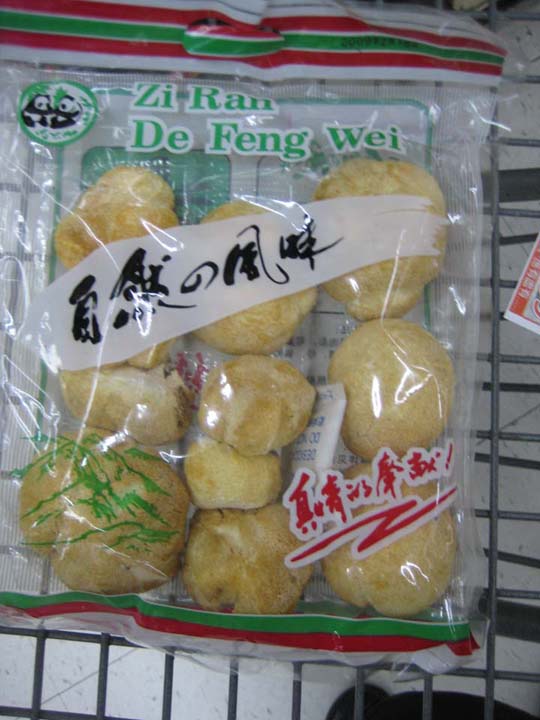 Also known as bear's head, old man's beard, sheep's tooth, lion's head, and most recently called the pom pom mushroom, these snow-white fungi have non-forking spine-like teeth that yellow and then brown as they age.
Also known as bear's head, old man's beard, sheep's tooth, lion's head, and most recently called the pom pom mushroom, these snow-white fungi have non-forking spine-like teeth that yellow and then brown as they age.
Grown in the Yunnan and the Heilongjiang Provinces, these loved mushrooms grow on dying or dead beech, maple, oak, and sycamore and are often found in triangular patches. They smell sweet and farinaceous, and are considered one of China's four delicacies, the others are bear's paw, bird's nest, and shark's fin.
Now cultivated in China and throughout Asia, these mushrooms, also known also as hedge hog mushrooms are botanically known as Herciium erinaceus. Before cultivation, they were rare and desirable because they were thought to be a brain tonic. Chinese medical personnel tell us they are considered of value for the elderly, are good for maintaining well-regulated digestion, to increase immunity, reduce blood pressure, help those with ulcers, keep high blood pressure in check, and are good for those with chronic atrophic gastritis. Newer uses include prescribing them for Alzheimer patients and others with neurologic brain diseases.
Fresh monkey head mushrooms can be cut into any desired shape, dried ones reconstituted by soaking in tepid water, then cut those ways, too. The Chinese love them with lots of ginger, with seafood, and with fresh herbs and other greens. For those who want to know more about them and want more recipes, go to Flavor and Fortune's Volume 8 on pages 20 and 21. And, use them in all soups including the one at the bottom of this article.
SILVER EAR MUSHROOMS are botanically known as Tremella fuciformis.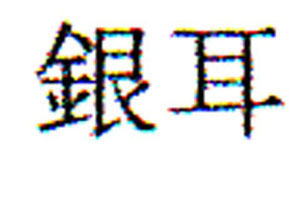
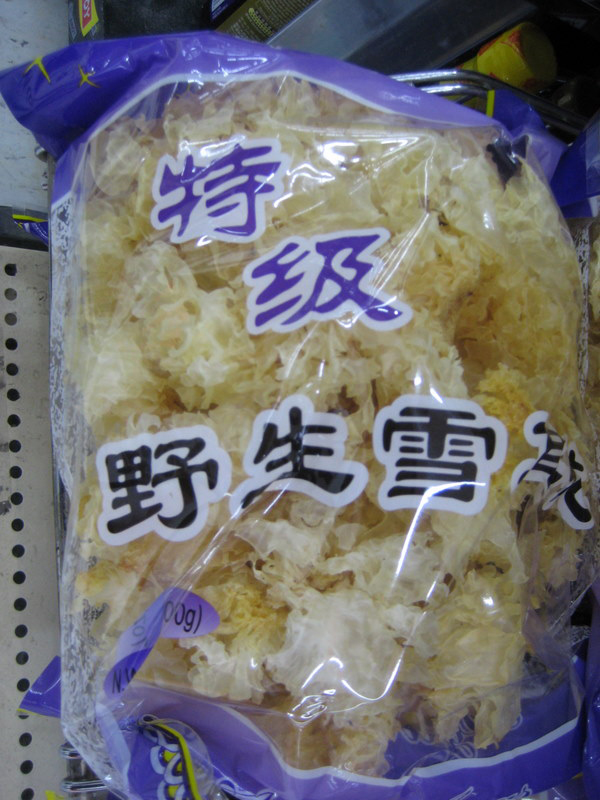 These mushrooms have been known and used in China for more than two thousand years. Most popular to sooth and heal coughs, they are also known as snow fungi, trembling fungi, white auricularia, white cloud ear mushrooms, and of course, silver ear mushrooms.
These mushrooms have been known and used in China for more than two thousand years. Most popular to sooth and heal coughs, they are also known as snow fungi, trembling fungi, white auricularia, white cloud ear mushrooms, and of course, silver ear mushrooms.
Jelly-like and nearly translucent when young, silver ears yellow with age, and when dried, if not dipped in a solution to maintain their white color. Grown in warm climates world-wide, they are often found on many live hardwoods including oak, poplar, willow, chestnut, maple, and eucalyptus trees.
Considered a woman's beautifying mushroom becasue an imperial concubine in the Tang Dynasty (618 - 907 CE) used them on her face and body. She was considered the most beautiful woman in China at that time. They are said to be rich in vitamin D and acidic polysaccharides. Chinese medical practitioners recommending them for lowering blood glucose and cholesterol, their anti-tumor and immune-stimulating properties, and as a protection against radiation. They also suggest them to remove freckles, increase gonadal activity, reduce fevers, and heal ulcers. In addition, Chinese TCM practitioners recommend them for weakness after childbirth, constipation, abnormal menstruation, and blood in the sputum.
Based upon the effects generated in blood and cholesterol-lowering seen in animal studies, much research is currently being conducted on people, lots on cancer patients needing radiation and chemotherapy, too.
In the Chinese culinary, chefs like to prepare them in sweet dishes, thin soups, and in fruit-like foods. Though gelatinous, they are preferred reconstituted from dry and re-hydrated because these ways they have better texture and remain more crisp, especially in cold dishes. These fungi are adored in foods where their own beauty can be appreciated, and where they can hold the taste of any sauce.
There were military generals, strategists all, who in retirement would cook these mushrooms with wolfberries. These red berries were called medlar but are now known as goji berries, their Chinese name. Red and symbols of blood with white fungi representing a pure reputation, when serving the emperor, these generals were prepared to die for him, even by sword.
| King Oyster Mushrooms with Tomatoes |
|---|
3 king oyster mushrooms 1/2 cup all-purpose flour 2 Tablespoons water chestnut flour 2 cups vegetable oil, for deep frying 1 Tablespoon minced fresh ginger 1 small hot chili pepper, seeded, then minced 1/2 sheet black or purple seaweed, minced 1 teaspoon black sesame seeds 1 teaspoon toasted white sesame seeds 1 Tablespoon oyster sauce 1 teaspoon crushed Chinese brown sugar 1 teaspoon sesame oil 3 Tablespoons minced Chinese celery 3 ripe plum tomatoes, blanched for fifteen seconds, then peeled and sliced the long way Preparation: 1. Slice the mushrooms on a slight angle, into half-inch wide slices. 2. Mix flour with three tablespoons cool water, beating to make a thin batter, then dip the mushroom slices in it coating them well. 3. Heat oil in a deep pot, then deep-fry a few mushroom slices at a time until they are golden, and drain them on paper towels. 4. Make a sauce mixing the minced ginger, chili pepper, seaweed, and both sesame seeds. Then add oyster sauce, crushed sugar, and the minced celery, and one tablespoon cold water. 5. Put a fried mushroom slice on a slice of tomato, and then pour the sauce mixture over them, and serve. |
| Taro-stuffed Oyster Mushrooms |
|---|
10 large oyster mushrooms 1 Tablespoon dried shrimp, soaked for one hour in half cup boiling water, then drained and minced, ooptional 2 Tablespoons Chinese rice wine 1/8 teaspoon ground white pepper 1 scallion, white part only, minced 1/2 teaspoon salt 1 teaspoon sugar 1/2 pound taro, steamed until soft 2 Tablespoons cornstarch 1 cup vegetable oil, for frying Ingredients: 1. Soak mushrooms with soaked and minced shrimp, rice wine, ground white pepper, minced scallion, salt and sugar for half an hour. Remove mushrooms and dry them with paper towels, and set marinade aside. 2. Mash taro and mix with marinade that was set aside. 3. Dust top the top side of each mushroom with cornstarch, removing any excess, and spread one tenth of the taro mixture on each mushroom. Allow to rest for one hour, then dust both sides of each mushroom with any remaining cornstarch and let rest for ten minutes. 4. Heat oil in a wok or a large pan and fry the mushrooms, filling side down until crisp, then turn over and fry for another minute. Then drain and serve. |
| Snow Peas and Pine Mushrooms |
|---|
1/2 pound pine mushrooms 1 teaspoon salt 1 Tablespoon Chinese Swatow rice wine 2 slices fresh ginger, smashed with side of a cleaver 1/2 teaspoon sesame oil 1 pound romaine lettuce, sliced into two inch pieces 2 Tablespoons vegetable oil, separated into two parts 10 quail eggs 2 scallions, cut into one-inch pieces 2 Tablespoons oyster sauce 6 cups chicken stock or water 2 Tablespoons cornstarch mixed with one tablespoon cold water Preparation: 1. Rinse mushrooms in two cups cold water mixed with the salt, and after ten minutes, discard the water and add rice wine, ginger, and the sesame oil, stir gently and let rest for ten minutes. 2. Bring four cups cold water to the boil, add one half the vegetable oil and the lettuce, stir then drain and set lettuce aside. 3. Bring one cup water to the boil, add the quail eggs, reduce heat and simmer for ten minutes. Remove the eggs, discard the water, and when cool enough to handle, peel the eggs carefully not tearing the white part. Then cut them in half and set aside. 4. Heat other half of the vegetable oil, and stir fry the scallions, then add the mushroom mixture and stir-fry for one minute before adding the oyster sauce and then six cups chicken broth or water, and then the cornstarch mixture, stirring until the broth or water clears before adding the lettuce and the quail eggs, simmer for one minute, then serve. |
| Reishi Mushroom Soup |
|---|
3 Tablespoons dried slices reishi mushrooms, soaked for three or more hours 1/2 pound pork shank bone 6 Chinese pitted brown dates, cut in small pieces 3 Chinese pitted black dates, cut in small pieces 1 piece, about two-inches square tangerine peel, soaked and then minced 2 Tablespoons granulated sugar Preparation: 1. Blanch reishi mushroom slices, then rinse with cold water, then soak for another two hours. 2. Blanch pork shank bone, put two quarts of boiling water, reduce heat, and simmer for two hours, then remove bone and scrape any meat into the water. 3. Add the drained mushroom pieces, those of the dates, and the tangerine peel and the sugar. Simmer another half hour, then serve. |
| Abalone, Monkey Head, and Chicken Soup |
|---|
3 dried monkey-head mushrooms 1 slice fresh ginger, smashed with side of a cleaver, then cut in four 1 scallion, minced 1 abalone, internal organs removed and discarded, then sliced 1/2 black chicken or a regular soup chicken, about one and a half pounds, cut into four pieces 1 pork shank bone, about one-half pound Preparation: 1. Soak dried mushroom with ginger and scallion for one hour, then remove, squeeze out any extra water, and slice them. Reserve the ginger and scallion pieces and add them to the soup just before serving. 2. Put mushrooms, reserved ginger and scallion pieces, abalone, pieces of chicken, and the pork shank bone into a large pot, add ten cups of water, and bring to the boil, but before it does boil, reduce the heat to a simmer, cover the pot, and simmer for three hours. 3. Remove chicken pieces, discard skin and bone, and remove the shank bone to take meat off it. Tear this meat into about ten pieces and return it to the soup. Skim any fat off the soup, and serve. |
| Silver Ear Dessert |
|---|
5 Tablespoons silver ear fungi 5 Tablespoons white rock sugar 3 Tablespoons goji berries 2 egg whites Preparation: 1. Put three to six cups water into a large pot, add the white silver ear fungi, bring to the boil, then reduce the heat and simmer for one hour (If planning to serve hot, use all the water; if wanting to serve this cold, use the lesser amount). 2. Add rock sugar and the goji berries, continue simmering for ten more minutes before adding the egg whites. Stir well. 3. Skim off any foam, and serve hot, warm, or cold. |

Copyright © 1994-2025 by ISACC, all rights reserved
Address
3 Jefferson Ferry Drive
S. Setauket NY 11720